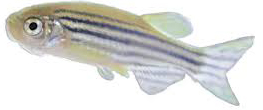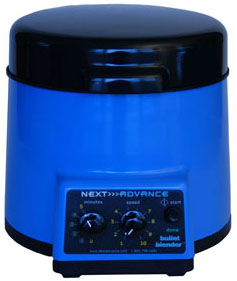Ideal for Zebrafish Samples Homogenization

Do you spend lots of time and effort homogenizing zebrafish samples? The Bullet Blender® is a multi-sample homogenizer that delivers high quality and superior yields. No other homogenizer comes close to delivering the Bullet Blender’s winning combination of top-quality performance and budget-friendly affordability.
The Bullet Blender®
Save Time, Effort and Get Superior Results
- Consistent and High Yield Results
Run up to 24 samples at the same time under microprocessor-controlled conditions, ensuring experimental reproducibility and high yield. Process samples from 10mg or less up to 3.5g. - No Cross Contamination
No part of the Bullet Blender® ever touches the zebrafish samples – the sample tubes are kept closed during homogenization. There are no probes to clean between samples. - Samples Stay Cool
Homogenizing causes only a few degrees of heating. Our Gold models keep samples at 4°C. - Easy and Convenient to Use
Just place beads and buffer along with your zebrafish sample in standard tubes, load tubes directly in the Bullet Blender, select time and speed, and press start. - Risk Free Purchase
The Bullet Blender® comes with a 30 day money back guarantee and a 2 year warranty, with a 3 year warranty on the motor. The simple, reliable design enables the Bullet Blenders to sell for a fraction of the price of ultrasonic or other agitation based instruments, yet provides an easier, quicker technique.

Bullet Blender settings for Zebrafish samples
Sample size |
See the Protocol |
| microcentrifuge tube model (up to 300 mg) | Small zebrafish samples |
| 5mL tube model (100mg – 1g) | Medium zebrafish samples |
Selected publications for Zebrafish samples
See all of our Bullet Blender publications!
2474232
zebrafish
items
1
0
date
desc
3305
https://www.nextadvance.com/wp-content/plugins/zotpress/
%7B%22status%22%3A%22success%22%2C%22updateneeded%22%3Afalse%2C%22instance%22%3A%22zotpress-c40a0c5173c667ea7f716a00c65331f6%22%2C%22meta%22%3A%7B%22request_last%22%3A0%2C%22request_next%22%3A0%2C%22used_cache%22%3Atrue%7D%2C%22data%22%3A%5B%7B%22key%22%3A%223FL5TVV7%22%2C%22library%22%3A%7B%22id%22%3A2474232%7D%2C%22meta%22%3A%7B%22creatorSummary%22%3A%22Sarasamma%20et%20al.%22%2C%22parsedDate%22%3A%222018-12-03%22%2C%22numChildren%22%3A1%7D%2C%22bib%22%3A%22%3Cdiv%20class%3D%5C%22csl-bib-body%5C%22%20style%3D%5C%22line-height%3A%202%3B%20padding-left%3A%201em%3B%20text-indent%3A-1em%3B%5C%22%3E%5Cn%20%20%3Cdiv%20class%3D%5C%22csl-entry%5C%22%3ESarasamma%2C%20S.%2C%20Audira%2C%20G.%2C%20Juniardi%2C%20S.%2C%20Sampurna%2C%20B.%2C%20Lai%2C%20Y.-H.%2C%20Hao%2C%20E.%2C%20Chen%2C%20J.-R.%2C%20%26amp%3B%20Hsiao%2C%20C.-D.%20%282018%29.%20Evaluation%20of%20the%20Effects%20of%20Carbon%2060%20Nanoparticle%20Exposure%20to%20Adult%20Zebrafish%3A%20A%20Behavioral%20and%20Biochemical%20Approach%20to%20Elucidate%20the%20Mechanism%20of%20Toxicity.%20%3Ci%3EInternational%20Journal%20of%20Molecular%20Sciences%3C%5C%2Fi%3E%2C%20%3Ci%3E19%3C%5C%2Fi%3E%2812%29%2C%203853.%20%3Ca%20href%3D%27https%3A%5C%2F%5C%2Fdoi.org%5C%2F10.3390%5C%2Fijms19123853%27%3Ehttps%3A%5C%2F%5C%2Fdoi.org%5C%2F10.3390%5C%2Fijms19123853%3C%5C%2Fa%3E%3C%5C%2Fdiv%3E%5Cn%3C%5C%2Fdiv%3E%22%2C%22data%22%3A%7B%22itemType%22%3A%22journalArticle%22%2C%22title%22%3A%22Evaluation%20of%20the%20Effects%20of%20Carbon%2060%20Nanoparticle%20Exposure%20to%20Adult%20Zebrafish%3A%20A%20Behavioral%20and%20Biochemical%20Approach%20to%20Elucidate%20the%20Mechanism%20of%20Toxicity%22%2C%22creators%22%3A%5B%7B%22creatorType%22%3A%22author%22%2C%22firstName%22%3A%22Sreeja%22%2C%22lastName%22%3A%22Sarasamma%22%7D%2C%7B%22creatorType%22%3A%22author%22%2C%22firstName%22%3A%22Gilbert%22%2C%22lastName%22%3A%22Audira%22%7D%2C%7B%22creatorType%22%3A%22author%22%2C%22firstName%22%3A%22Stevhen%22%2C%22lastName%22%3A%22Juniardi%22%7D%2C%7B%22creatorType%22%3A%22author%22%2C%22firstName%22%3A%22Bonifasius%22%2C%22lastName%22%3A%22Sampurna%22%7D%2C%7B%22creatorType%22%3A%22author%22%2C%22firstName%22%3A%22Yu-Heng%22%2C%22lastName%22%3A%22Lai%22%7D%2C%7B%22creatorType%22%3A%22author%22%2C%22firstName%22%3A%22Erwei%22%2C%22lastName%22%3A%22Hao%22%7D%2C%7B%22creatorType%22%3A%22author%22%2C%22firstName%22%3A%22Jung-Ren%22%2C%22lastName%22%3A%22Chen%22%7D%2C%7B%22creatorType%22%3A%22author%22%2C%22firstName%22%3A%22Chung-Der%22%2C%22lastName%22%3A%22Hsiao%22%7D%5D%2C%22abstractNote%22%3A%22There%20is%20a%20growing%20concern%20for%20the%20potential%20toxicity%20of%20engineered%20nanomaterials%20that%20have%20made%20their%20way%20into%20virtually%20all%20novel%20applications%20in%20the%20electronics%2C%20healthcare%2C%20cosmetics%2C%20technology%2C%20and%20engineering%20industries%2C%20and%20in%20particular%2C%20biomedical%20products.%20However%2C%20the%20potential%20toxicity%20of%20carbon%2060%20%28C60%29%20at%20the%20behavioral%20level%20has%20not%20been%20properly%20evaluated.%20In%20this%20study%2C%20we%20used%20idTracker%2C%20a%20multitracking%20algorithm%20to%20quantitatively%20assess%20behavioral%20toxicity%20induced%20by%20C60%20nanoparticles%20%28C60%20NPs%29%20in%20adult%20zebrafish.%20We%20demonstrated%20that%20locomotion%2C%20novel%20tank%20exploration%2C%20aggression%2C%20shoaling%2C%20and%20color%20preference%20activities%20of%20the%20C60%20NPs-treated%20fish%20was%20significantly%20reduced.%20In%20addition%2C%20the%20C60%20NPs-treated%20fish%20also%20displayed%20dysregulation%20of%20the%20circadian%20rhythm%20by%20showing%20lower%20locomotion%20activities%20in%20both%20day%20and%20night%20cycles.%20The%20biochemical%20results%20showed%20that%20C60%20NPs%20exposure%20at%20low%20concentration%20induced%20oxidative%20stress%20and%20DNA%20damage%2C%20reduced%20anti-oxidative%20capacity%20and%20ATP%20%28adenosine%20triphosphate%29%20levels%2C%20and%20induced%20stress-associated%20hormones%2C%20hypoxia%2C%20as%20well%20as%20inflammation%20marker%20upregulation%20in%20muscle%20and%20gill%20tissues.%20Together%2C%20this%20work%2C%20for%20the%20first%20time%2C%20provide%20direct%20evidence%20showing%20that%20the%20chronic%20exposure%20of%20C60%20NPs%20induced%20multiple%20behavioral%20abnormalities%20in%20adult%20zebrafish.%20Our%20findings%20suggest%20that%20the%20ecotoxicity%20of%20C60%20NPs%20towards%20aquatic%20vertebrates%20should%20be%20carefully%20evaluated.%22%2C%22date%22%3A%222018-12-03%22%2C%22language%22%3A%22en%22%2C%22DOI%22%3A%2210.3390%5C%2Fijms19123853%22%2C%22ISSN%22%3A%221422-0067%22%2C%22url%22%3A%22http%3A%5C%2F%5C%2Fwww.mdpi.com%5C%2F1422-0067%5C%2F19%5C%2F12%5C%2F3853%22%2C%22collections%22%3A%5B%22M2MNG549%22%5D%2C%22dateModified%22%3A%222020-01-23T21%3A37%3A10Z%22%7D%7D%2C%7B%22key%22%3A%22RTSVJCGB%22%2C%22library%22%3A%7B%22id%22%3A2474232%7D%2C%22meta%22%3A%7B%22creatorSummary%22%3A%22McDougall%20et%20al.%22%2C%22parsedDate%22%3A%222016-08%22%2C%22numChildren%22%3A2%7D%2C%22bib%22%3A%22%3Cdiv%20class%3D%5C%22csl-bib-body%5C%22%20style%3D%5C%22line-height%3A%202%3B%20padding-left%3A%201em%3B%20text-indent%3A-1em%3B%5C%22%3E%5Cn%20%20%3Cdiv%20class%3D%5C%22csl-entry%5C%22%3EMcDougall%2C%20M.%20Q.%2C%20Choi%2C%20J.%2C%20Stevens%2C%20J.%20F.%2C%20Truong%2C%20L.%2C%20Tanguay%2C%20R.%20L.%2C%20%26amp%3B%20Traber%2C%20M.%20G.%20%282016%29.%20Lipidomics%20and%20H218O%20labeling%20techniques%20reveal%20increased%20remodeling%20of%20DHA-containing%20membrane%20phospholipids%20associated%20with%20abnormal%20locomotor%20responses%20in%20%26%23x3B1%3B-tocopherol%20deficient%20zebrafish%20%28danio%20rerio%29%20embryos.%20%3Ci%3ERedox%20Biology%3C%5C%2Fi%3E%2C%20%3Ci%3E8%3C%5C%2Fi%3E%2C%20165%26%23x2013%3B174.%20%3Ca%20href%3D%27https%3A%5C%2F%5C%2Fdoi.org%5C%2F10.1016%5C%2Fj.redox.2016.01.004%27%3Ehttps%3A%5C%2F%5C%2Fdoi.org%5C%2F10.1016%5C%2Fj.redox.2016.01.004%3C%5C%2Fa%3E%3C%5C%2Fdiv%3E%5Cn%3C%5C%2Fdiv%3E%22%2C%22data%22%3A%7B%22itemType%22%3A%22journalArticle%22%2C%22title%22%3A%22Lipidomics%20and%20H218O%20labeling%20techniques%20reveal%20increased%20remodeling%20of%20DHA-containing%20membrane%20phospholipids%20associated%20with%20abnormal%20locomotor%20responses%20in%20%5Cu03b1-tocopherol%20deficient%20zebrafish%20%28danio%20rerio%29%20embryos%22%2C%22creators%22%3A%5B%7B%22creatorType%22%3A%22author%22%2C%22firstName%22%3A%22Melissa%20Q.%22%2C%22lastName%22%3A%22McDougall%22%7D%2C%7B%22creatorType%22%3A%22author%22%2C%22firstName%22%3A%22Jaewoo%22%2C%22lastName%22%3A%22Choi%22%7D%2C%7B%22creatorType%22%3A%22author%22%2C%22firstName%22%3A%22Jan%20F.%22%2C%22lastName%22%3A%22Stevens%22%7D%2C%7B%22creatorType%22%3A%22author%22%2C%22firstName%22%3A%22Lisa%22%2C%22lastName%22%3A%22Truong%22%7D%2C%7B%22creatorType%22%3A%22author%22%2C%22firstName%22%3A%22Robert%20L.%22%2C%22lastName%22%3A%22Tanguay%22%7D%2C%7B%22creatorType%22%3A%22author%22%2C%22firstName%22%3A%22Maret%20G.%22%2C%22lastName%22%3A%22Traber%22%7D%5D%2C%22abstractNote%22%3A%22We%20hypothesized%20that%20vitamin%20E%20%28%5Cu03b1-tocopherol%29%20is%20required%20by%20the%20developing%20embryonic%20brain%20to%20prevent%20depletion%20of%20highly%20polyunsaturated%20fatty%20acids%2C%20especially%20docosahexaenoic%20acid%20%28DHA%2C%2022%3A6%29%2C%20the%20loss%20of%20which%20we%20predicted%20would%20underlie%20abnormal%20morphological%20and%20behavioral%20outcomes.%20Therefore%2C%20we%20fed%20adult%205D%20zebrafish%20%28Danio%20rerio%29%20defined%20diets%20without%20%28E%5Cu2212%29%20or%20with%20added%20%5Cu03b1-tocopherol%20%28E%2B%2C%20500%20mg%20RRR-%5Cu03b1-tocopheryl%20acetate%5C%2Fkg%20diet%29%20for%20a%20minimum%20of%2080%20days%2C%20and%20then%20spawned%20them%20to%20obtain%20E%5Cu2212%20and%20E%2B%20embryos.%20The%20E%5Cu2212%20compared%20with%20E%2B%20embryos%20were%2082%25%20less%20responsive%20%28p%26lt%3B0.01%29%20to%20a%20light%5C%2Fdark%20stimulus%20at%2096%20h%20post-fertilization%20%28hpf%29%2C%20demonstrating%20impaired%20locomotor%20behavior%2C%20even%20in%20the%20absence%20of%20gross%20morphological%20defects.%20Evaluation%20of%20phospholipid%20%28PL%29%20and%20lysophospholipid%20%28lyso-PL%29%20composition%20using%20untargeted%20lipidomics%20in%20E%5Cu2212%20compared%20with%20E%2B%20embryos%20at%2024%2C%2048%2C%2072%2C%20and%20120%20hpf%20showed%20that%20four%20PLs%20and%20three%20lyso-PLs%20containing%20docosahexaenoic%20acid%20%28DHA%29%2C%20including%20lysophosphatidylcholine%20%28LPC%2022%3A6%2C%20required%20for%20transport%20of%20DHA%20into%20the%20brain%2C%20p%26lt%3B0.001%29%2C%20were%20at%20lower%20concentrations%20in%20E%5Cu2212%20at%20all%20time-points.%20Additionally%2C%20H218O%20labeling%20experiments%20revealed%20enhanced%20turnover%20of%20LPC%2022%3A6%20%28p%26lt%3B0.001%29%20and%20three%20other%20DHA-containing%20PLs%20in%20the%20E%5Cu2212%20compared%20with%20the%20E%2B%20embryos%2C%20suggesting%20that%20increased%20membrane%20remodeling%20is%20a%20result%20of%20PL%20depletion.%20Together%2C%20these%20data%20indicate%20that%20%5Cu03b1-tocopherol%20deficiency%20in%20the%20zebrafish%20embryo%20causes%20the%20specific%20depletion%20and%20increased%20turnover%20of%20DHA-containing%20PL%20and%20lyso-PLs%2C%20which%20may%20compromise%20DHA%20delivery%20to%20the%20brain%20and%20thereby%20contribute%20to%20the%20functional%20impairments%20observed%20in%20E%5Cu2212%20embryos.%22%2C%22date%22%3A%22August%202016%22%2C%22language%22%3A%22%22%2C%22DOI%22%3A%2210.1016%5C%2Fj.redox.2016.01.004%22%2C%22ISSN%22%3A%222213-2317%22%2C%22url%22%3A%22http%3A%5C%2F%5C%2Fwww.sciencedirect.com%5C%2Fscience%5C%2Farticle%5C%2Fpii%5C%2FS2213231716300064%22%2C%22collections%22%3A%5B%22M2MNG549%22%5D%2C%22dateModified%22%3A%222016-06-10T18%3A18%3A26Z%22%7D%7D%2C%7B%22key%22%3A%22EEFS2SFV%22%2C%22library%22%3A%7B%22id%22%3A2474232%7D%2C%22meta%22%3A%7B%22creatorSummary%22%3A%22Chatzopoulou%20et%20al.%22%2C%22parsedDate%22%3A%222016-05-24%22%2C%22numChildren%22%3A1%7D%2C%22bib%22%3A%22%3Cdiv%20class%3D%5C%22csl-bib-body%5C%22%20style%3D%5C%22line-height%3A%202%3B%20padding-left%3A%201em%3B%20text-indent%3A-1em%3B%5C%22%3E%5Cn%20%20%3Cdiv%20class%3D%5C%22csl-entry%5C%22%3EChatzopoulou%2C%20A.%2C%20Heijmans%2C%20J.%20P.%20M.%2C%20Burgerhout%2C%20E.%2C%20Oskam%2C%20N.%2C%20Spaink%2C%20H.%20P.%2C%20Meijer%2C%20A.%20H.%2C%20%26amp%3B%20Schaaf%2C%20M.%20J.%20M.%20%282016%29.%20Glucocorticoid-induced%20attenuation%20of%20the%20inflammatory%20response%20in%20zebrafish.%20%3Ci%3EEndocrinology%3C%5C%2Fi%3E%2C%20en20152050.%20%3Ca%20href%3D%27https%3A%5C%2F%5C%2Fdoi.org%5C%2F10.1210%5C%2Fen.2015-2050%27%3Ehttps%3A%5C%2F%5C%2Fdoi.org%5C%2F10.1210%5C%2Fen.2015-2050%3C%5C%2Fa%3E%3C%5C%2Fdiv%3E%5Cn%3C%5C%2Fdiv%3E%22%2C%22data%22%3A%7B%22itemType%22%3A%22journalArticle%22%2C%22title%22%3A%22Glucocorticoid-induced%20attenuation%20of%20the%20inflammatory%20response%20in%20zebrafish%22%2C%22creators%22%3A%5B%7B%22creatorType%22%3A%22author%22%2C%22firstName%22%3A%22Antonia%22%2C%22lastName%22%3A%22Chatzopoulou%22%7D%2C%7B%22creatorType%22%3A%22author%22%2C%22firstName%22%3A%22Jeroen%20P.%20M.%22%2C%22lastName%22%3A%22Heijmans%22%7D%2C%7B%22creatorType%22%3A%22author%22%2C%22firstName%22%3A%22Erik%22%2C%22lastName%22%3A%22Burgerhout%22%7D%2C%7B%22creatorType%22%3A%22author%22%2C%22firstName%22%3A%22Nienke%22%2C%22lastName%22%3A%22Oskam%22%7D%2C%7B%22creatorType%22%3A%22author%22%2C%22firstName%22%3A%22Herman%20P.%22%2C%22lastName%22%3A%22Spaink%22%7D%2C%7B%22creatorType%22%3A%22author%22%2C%22firstName%22%3A%22Annemarie%20H.%22%2C%22lastName%22%3A%22Meijer%22%7D%2C%7B%22creatorType%22%3A%22author%22%2C%22firstName%22%3A%22Marcel%20J.%20M.%22%2C%22lastName%22%3A%22Schaaf%22%7D%5D%2C%22abstractNote%22%3A%22Glucocorticoids%20are%20steroid%20hormones%20that%20are%20secreted%20upon%20stress.%20Their%20effects%20are%20mediated%20by%20the%20glucocorticoid%20receptor%20%28GR%29%20which%20acts%20as%20a%20transcription%20factor.%20Since%20the%20anti-inflammatory%20activity%20of%20glucocorticoids%20has%20been%20well%20established%2C%20they%20are%20widely%20used%20clinically%20to%20treat%20many%20inflammatory%20and%20immune-related%20diseases.%20However%2C%20the%20exact%20specificity%2C%20mechanisms%20and%20level%20of%20regulation%20of%20different%20inflammatory%20pathways%20have%20not%20been%20fully%20elucidated.%20In%20the%20present%20study%2C%20a%20tail%20fin%20amputation%20assay%20was%20employed%20in%203-day-old%20zebrafish%20larvae%20to%20study%20the%20immunomodulatory%20effects%20of%20the%20synthetic%20glucocorticoid%20beclomethasone.%20First%2C%20a%20transcriptome%20analysis%20was%20performed%2C%20which%20showed%20that%20upon%20amputation%20mainly%20immune-related%20genes%20are%20regulated.%20This%20regulation%20was%20inhibited%20by%20beclomethasone%20for%2086%20of%20regulated%20genes.%20For%20two%20immune-related%20genes%2C%20tlr4bb%20and%20alox5ap%2C%20the%20amputation-induced%20increase%20was%20not%20attenuated%20by%20beclomethasone.%20Alox5ap%20is%20involved%20in%20eicosanoid%20biosynthesis%2C%20but%20the%20increase%20in%20LTB4%20concentration%20upon%20amputation%20was%20abolished%2C%20and%20LXA4%20levels%20were%20unaffected%20by%20beclomethasone.%20Furthermore%2C%20we%20studied%20the%20migration%20of%20neutrophils%20and%20macrophages%20towards%20the%20wound%20site.%20Our%20results%20show%20that%20amputation%20induced%20migration%20of%20both%20types%20of%20leukocytes%2C%20and%20that%20this%20migration%20was%20dependent%20on%20de%20novo%20protein%20synthesis.%20Beclomethasone%20treatment%20attenuated%20the%20migratory%20behavior%20of%20neutrophils%20in%20a%20GR-dependent%20manner%2C%20but%20left%20the%20migration%20of%20macrophages%20unaffected.%20In%20conclusion%2C%20beclomethasone%20has%20a%20dramatic%20inhibitory%20effect%20on%20the%20amputation-induced%20pro-inflammatory%20gene%20regulation%2C%20and%20this%20is%20reflected%20in%20an%20inhibition%20of%20the%20neutrophil%20migration%2C%20but%20not%20the%20migration%20of%20macrophages%2C%20which%20are%20likely%20to%20be%20involved%20in%20inflammation%20resolution.%22%2C%22date%22%3A%22May%2024%2C%202016%22%2C%22language%22%3A%22ENG%22%2C%22DOI%22%3A%2210.1210%5C%2Fen.2015-2050%22%2C%22ISSN%22%3A%221945-7170%22%2C%22url%22%3A%22%22%2C%22collections%22%3A%5B%22M2MNG549%22%5D%2C%22dateModified%22%3A%222016-06-29T19%3A45%3A18Z%22%7D%7D%2C%7B%22key%22%3A%22DIRPZJPG%22%2C%22library%22%3A%7B%22id%22%3A2474232%7D%2C%22meta%22%3A%7B%22creatorSummary%22%3A%22Goodale%20et%20al.%22%2C%22parsedDate%22%3A%222015-07-03%22%2C%22numChildren%22%3A0%7D%2C%22bib%22%3A%22%3Cdiv%20class%3D%5C%22csl-bib-body%5C%22%20style%3D%5C%22line-height%3A%202%3B%20padding-left%3A%201em%3B%20text-indent%3A-1em%3B%5C%22%3E%5Cn%20%20%3Cdiv%20class%3D%5C%22csl-entry%5C%22%3EGoodale%2C%20B.%20C.%2C%20La%20Du%2C%20J.%2C%20Tilton%2C%20S.%20C.%2C%20Sullivan%2C%20C.%20M.%2C%20Bisson%2C%20W.%20H.%2C%20Waters%2C%20K.%20M.%2C%20%26amp%3B%20Tanguay%2C%20R.%20L.%20%282015%29.%20Ligand-specific%20transcriptional%20mechanisms%20underlie%20aryl%20hydrocarbon%20receptor-mediated%20developmental%20toxicity%20of%20oxygenated%20PAHs.%20%3Ci%3EToxicological%20Sciences%3C%5C%2Fi%3E%2C%20kfv139.%20%3Ca%20href%3D%27https%3A%5C%2F%5C%2Fdoi.org%5C%2F10.1093%5C%2Ftoxsci%5C%2Fkfv139%27%3Ehttps%3A%5C%2F%5C%2Fdoi.org%5C%2F10.1093%5C%2Ftoxsci%5C%2Fkfv139%3C%5C%2Fa%3E%3C%5C%2Fdiv%3E%5Cn%3C%5C%2Fdiv%3E%22%2C%22data%22%3A%7B%22itemType%22%3A%22journalArticle%22%2C%22title%22%3A%22Ligand-specific%20transcriptional%20mechanisms%20underlie%20aryl%20hydrocarbon%20receptor-mediated%20developmental%20toxicity%20of%20oxygenated%20PAHs%22%2C%22creators%22%3A%5B%7B%22creatorType%22%3A%22author%22%2C%22firstName%22%3A%22B.C.%22%2C%22lastName%22%3A%22Goodale%22%7D%2C%7B%22creatorType%22%3A%22author%22%2C%22firstName%22%3A%22J.%22%2C%22lastName%22%3A%22La%20Du%22%7D%2C%7B%22creatorType%22%3A%22author%22%2C%22firstName%22%3A%22S.C.%22%2C%22lastName%22%3A%22Tilton%22%7D%2C%7B%22creatorType%22%3A%22author%22%2C%22firstName%22%3A%22C.M.%22%2C%22lastName%22%3A%22Sullivan%22%7D%2C%7B%22creatorType%22%3A%22author%22%2C%22firstName%22%3A%22W.H.%22%2C%22lastName%22%3A%22Bisson%22%7D%2C%7B%22creatorType%22%3A%22author%22%2C%22firstName%22%3A%22K.M.%22%2C%22lastName%22%3A%22Waters%22%7D%2C%7B%22creatorType%22%3A%22author%22%2C%22firstName%22%3A%22R.L.%22%2C%22lastName%22%3A%22Tanguay%22%7D%5D%2C%22abstractNote%22%3A%22%22%2C%22date%22%3A%222015-07-03%22%2C%22language%22%3A%22en%22%2C%22DOI%22%3A%2210.1093%5C%2Ftoxsci%5C%2Fkfv139%22%2C%22ISSN%22%3A%221096-6080%2C%201096-0929%22%2C%22url%22%3A%22http%3A%5C%2F%5C%2Fwww.toxsci.oxfordjournals.org%5C%2Flookup%5C%2Fdoi%5C%2F10.1093%5C%2Ftoxsci%5C%2Fkfv139%22%2C%22collections%22%3A%5B%22M2MNG549%22%5D%2C%22dateModified%22%3A%222015-08-17T17%3A48%3A08Z%22%7D%7D%2C%7B%22key%22%3A%22FBIWURJE%22%2C%22library%22%3A%7B%22id%22%3A2474232%7D%2C%22meta%22%3A%7B%22creatorSummary%22%3A%22Techer%20et%20al.%22%2C%22parsedDate%22%3A%222015%22%2C%22numChildren%22%3A0%7D%2C%22bib%22%3A%22%3Cdiv%20class%3D%5C%22csl-bib-body%5C%22%20style%3D%5C%22line-height%3A%202%3B%20padding-left%3A%201em%3B%20text-indent%3A-1em%3B%5C%22%3E%5Cn%20%20%3Cdiv%20class%3D%5C%22csl-entry%5C%22%3ETecher%2C%20D.%2C%20Milla%2C%20S.%2C%20Fontaine%2C%20P.%2C%20Viot%2C%20S.%2C%20%26amp%3B%20Thomas%2C%20M.%20%282015%29.%20Influence%20of%20waterborne%20gallic%20and%20pelargonic%20acid%20exposures%20on%20biochemical%20and%20reproductive%20parameters%20in%20the%20zebrafish%20%28%20%3Ci%3EDanio%20rerio%3C%5C%2Fi%3E%20%29%3A%20Influence%20Of%20Gallic%20and%20Pelargonic%20Acid%20Exposure.%20%3Ci%3EEnvironmental%20Toxicology%3C%5C%2Fi%3E%2C%20n%5C%2Fa-n%5C%2Fa.%20%3Ca%20href%3D%27https%3A%5C%2F%5C%2Fdoi.org%5C%2F10.1002%5C%2Ftox.22228%27%3Ehttps%3A%5C%2F%5C%2Fdoi.org%5C%2F10.1002%5C%2Ftox.22228%3C%5C%2Fa%3E%3C%5C%2Fdiv%3E%5Cn%3C%5C%2Fdiv%3E%22%2C%22data%22%3A%7B%22itemType%22%3A%22journalArticle%22%2C%22title%22%3A%22Influence%20of%20waterborne%20gallic%20and%20pelargonic%20acid%20exposures%20on%20biochemical%20and%20reproductive%20parameters%20in%20the%20zebrafish%20%28%20%3Ci%3EDanio%20rerio%3C%5C%2Fi%3E%20%29%3A%20Influence%20Of%20Gallic%20and%20Pelargonic%20Acid%20Exposure%22%2C%22creators%22%3A%5B%7B%22creatorType%22%3A%22author%22%2C%22firstName%22%3A%22Didier%22%2C%22lastName%22%3A%22Techer%22%7D%2C%7B%22creatorType%22%3A%22author%22%2C%22firstName%22%3A%22Sylvain%22%2C%22lastName%22%3A%22Milla%22%7D%2C%7B%22creatorType%22%3A%22author%22%2C%22firstName%22%3A%22Pascal%22%2C%22lastName%22%3A%22Fontaine%22%7D%2C%7B%22creatorType%22%3A%22author%22%2C%22firstName%22%3A%22Sandrine%22%2C%22lastName%22%3A%22Viot%22%7D%2C%7B%22creatorType%22%3A%22author%22%2C%22firstName%22%3A%22Marielle%22%2C%22lastName%22%3A%22Thomas%22%7D%5D%2C%22abstractNote%22%3A%22%22%2C%22date%22%3A%2212%5C%2F2015%22%2C%22language%22%3A%22en%22%2C%22DOI%22%3A%2210.1002%5C%2Ftox.22228%22%2C%22ISSN%22%3A%2215204081%22%2C%22url%22%3A%22http%3A%5C%2F%5C%2Fdoi.wiley.com%5C%2F10.1002%5C%2Ftox.22228%22%2C%22collections%22%3A%5B%22M2MNG549%22%5D%2C%22dateModified%22%3A%222015-12-31T21%3A00%3A13Z%22%7D%7D%2C%7B%22key%22%3A%22NUGCIXQF%22%2C%22library%22%3A%7B%22id%22%3A2474232%7D%2C%22meta%22%3A%7B%22creatorSummary%22%3A%22Doldur-Balli%20et%20al.%22%2C%22parsedDate%22%3A%222015%22%2C%22numChildren%22%3A0%7D%2C%22bib%22%3A%22%3Cdiv%20class%3D%5C%22csl-bib-body%5C%22%20style%3D%5C%22line-height%3A%202%3B%20padding-left%3A%201em%3B%20text-indent%3A-1em%3B%5C%22%3E%5Cn%20%20%3Cdiv%20class%3D%5C%22csl-entry%5C%22%3EDoldur-Balli%2C%20F.%2C%20Ozel%2C%20M.%20N.%2C%20Gulsuner%2C%20S.%2C%20Tekinay%2C%20A.%20B.%2C%20Ozcelik%2C%20T.%2C%20Konu%2C%20O.%2C%20%26amp%3B%20Adams%2C%20M.%20M.%20%282015%29.%20Characterization%20of%20a%20novel%20zebrafish%20%28Danio%20rerio%29%20gene%2C%20wdr81%2C%20associated%20with%20cerebellar%20ataxia%2C%20mental%20retardation%20and%20dysequilibrium%20syndrome%20%28CAMRQ%29.%20%3Ci%3EBMC%20Neuroscience%3C%5C%2Fi%3E%2C%20%3Ci%3E16%3C%5C%2Fi%3E%281%29.%20%3Ca%20href%3D%27https%3A%5C%2F%5C%2Fdoi.org%5C%2F10.1186%5C%2Fs12868-015-0229-4%27%3Ehttps%3A%5C%2F%5C%2Fdoi.org%5C%2F10.1186%5C%2Fs12868-015-0229-4%3C%5C%2Fa%3E%3C%5C%2Fdiv%3E%5Cn%3C%5C%2Fdiv%3E%22%2C%22data%22%3A%7B%22itemType%22%3A%22journalArticle%22%2C%22title%22%3A%22Characterization%20of%20a%20novel%20zebrafish%20%28Danio%20rerio%29%20gene%2C%20wdr81%2C%20associated%20with%20cerebellar%20ataxia%2C%20mental%20retardation%20and%20dysequilibrium%20syndrome%20%28CAMRQ%29%22%2C%22creators%22%3A%5B%7B%22creatorType%22%3A%22author%22%2C%22firstName%22%3A%22Fusun%22%2C%22lastName%22%3A%22Doldur-Balli%22%7D%2C%7B%22creatorType%22%3A%22author%22%2C%22firstName%22%3A%22Mehmet%20Neset%22%2C%22lastName%22%3A%22Ozel%22%7D%2C%7B%22creatorType%22%3A%22author%22%2C%22firstName%22%3A%22Suleyman%22%2C%22lastName%22%3A%22Gulsuner%22%7D%2C%7B%22creatorType%22%3A%22author%22%2C%22firstName%22%3A%22Ayse%20B.%22%2C%22lastName%22%3A%22Tekinay%22%7D%2C%7B%22creatorType%22%3A%22author%22%2C%22firstName%22%3A%22Tayfun%22%2C%22lastName%22%3A%22Ozcelik%22%7D%2C%7B%22creatorType%22%3A%22author%22%2C%22firstName%22%3A%22Ozlen%22%2C%22lastName%22%3A%22Konu%22%7D%2C%7B%22creatorType%22%3A%22author%22%2C%22firstName%22%3A%22Michelle%20M.%22%2C%22lastName%22%3A%22Adams%22%7D%5D%2C%22abstractNote%22%3A%22%22%2C%22date%22%3A%2212%5C%2F2015%22%2C%22language%22%3A%22en%22%2C%22DOI%22%3A%2210.1186%5C%2Fs12868-015-0229-4%22%2C%22ISSN%22%3A%221471-2202%22%2C%22url%22%3A%22http%3A%5C%2F%5C%2Fwww.biomedcentral.com%5C%2F1471-2202%5C%2F16%5C%2F96%22%2C%22collections%22%3A%5B%22M2MNG549%22%5D%2C%22dateModified%22%3A%222015-12-30T18%3A54%3A48Z%22%7D%7D%2C%7B%22key%22%3A%22M34F2TNK%22%2C%22library%22%3A%7B%22id%22%3A2474232%7D%2C%22meta%22%3A%7B%22creatorSummary%22%3A%22Wong%20and%20Godwin%22%2C%22parsedDate%22%3A%222015%22%2C%22numChildren%22%3A0%7D%2C%22bib%22%3A%22%3Cdiv%20class%3D%5C%22csl-bib-body%5C%22%20style%3D%5C%22line-height%3A%202%3B%20padding-left%3A%201em%3B%20text-indent%3A-1em%3B%5C%22%3E%5Cn%20%20%3Cdiv%20class%3D%5C%22csl-entry%5C%22%3EWong%2C%20R.%20Y.%2C%20%26amp%3B%20Godwin%2C%20J.%20%282015%29.%20Neurotranscriptome%20profiles%20of%20multiple%20zebrafish%20strains.%20%3Ci%3EGenomics%20Data%3C%5C%2Fi%3E%2C%20%3Ci%3E5%3C%5C%2Fi%3E%2C%20206%26%23x2013%3B209.%20%3Ca%20href%3D%27https%3A%5C%2F%5C%2Fdoi.org%5C%2F10.1016%5C%2Fj.gdata.2015.06.004%27%3Ehttps%3A%5C%2F%5C%2Fdoi.org%5C%2F10.1016%5C%2Fj.gdata.2015.06.004%3C%5C%2Fa%3E%3C%5C%2Fdiv%3E%5Cn%3C%5C%2Fdiv%3E%22%2C%22data%22%3A%7B%22itemType%22%3A%22journalArticle%22%2C%22title%22%3A%22Neurotranscriptome%20profiles%20of%20multiple%20zebrafish%20strains%22%2C%22creators%22%3A%5B%7B%22creatorType%22%3A%22author%22%2C%22firstName%22%3A%22Ryan%20Y.%22%2C%22lastName%22%3A%22Wong%22%7D%2C%7B%22creatorType%22%3A%22author%22%2C%22firstName%22%3A%22John%22%2C%22lastName%22%3A%22Godwin%22%7D%5D%2C%22abstractNote%22%3A%22%22%2C%22date%22%3A%2209%5C%2F2015%22%2C%22language%22%3A%22en%22%2C%22DOI%22%3A%2210.1016%5C%2Fj.gdata.2015.06.004%22%2C%22ISSN%22%3A%2222135960%22%2C%22url%22%3A%22http%3A%5C%2F%5C%2Flinkinghub.elsevier.com%5C%2Fretrieve%5C%2Fpii%5C%2FS2213596015001051%22%2C%22collections%22%3A%5B%22M2MNG549%22%5D%2C%22dateModified%22%3A%222015-08-03T14%3A24%3A43Z%22%7D%7D%2C%7B%22key%22%3A%22X7S55V5H%22%2C%22library%22%3A%7B%22id%22%3A2474232%7D%2C%22meta%22%3A%7B%22creatorSummary%22%3A%22Elie%20et%20al.%22%2C%22parsedDate%22%3A%222015%22%2C%22numChildren%22%3A0%7D%2C%22bib%22%3A%22%3Cdiv%20class%3D%5C%22csl-bib-body%5C%22%20style%3D%5C%22line-height%3A%202%3B%20padding-left%3A%201em%3B%20text-indent%3A-1em%3B%5C%22%3E%5Cn%20%20%3Cdiv%20class%3D%5C%22csl-entry%5C%22%3EElie%2C%20M.%20R.%2C%20Choi%2C%20J.%2C%20Nkrumah-Elie%2C%20Y.%20M.%2C%20Gonnerman%2C%20G.%20D.%2C%20Stevens%2C%20J.%20F.%2C%20%26amp%3B%20Tanguay%2C%20R.%20L.%20%282015%29.%20Metabolomic%20analysis%20to%20define%20and%20compare%20the%20effects%20of%20PAHs%20and%20oxygenated%20PAHs%20in%20developing%20zebrafish.%20%3Ci%3EEnvironmental%20Research%3C%5C%2Fi%3E%2C%20%3Ci%3E140%3C%5C%2Fi%3E%2C%20502%26%23x2013%3B510.%20%3Ca%20href%3D%27https%3A%5C%2F%5C%2Fdoi.org%5C%2F10.1016%5C%2Fj.envres.2015.05.009%27%3Ehttps%3A%5C%2F%5C%2Fdoi.org%5C%2F10.1016%5C%2Fj.envres.2015.05.009%3C%5C%2Fa%3E%3C%5C%2Fdiv%3E%5Cn%3C%5C%2Fdiv%3E%22%2C%22data%22%3A%7B%22itemType%22%3A%22journalArticle%22%2C%22title%22%3A%22Metabolomic%20analysis%20to%20define%20and%20compare%20the%20effects%20of%20PAHs%20and%20oxygenated%20PAHs%20in%20developing%20zebrafish%22%2C%22creators%22%3A%5B%7B%22creatorType%22%3A%22author%22%2C%22firstName%22%3A%22Marc%20R.%22%2C%22lastName%22%3A%22Elie%22%7D%2C%7B%22creatorType%22%3A%22author%22%2C%22firstName%22%3A%22Jaewoo%22%2C%22lastName%22%3A%22Choi%22%7D%2C%7B%22creatorType%22%3A%22author%22%2C%22firstName%22%3A%22Yasmeen%20M.%22%2C%22lastName%22%3A%22Nkrumah-Elie%22%7D%2C%7B%22creatorType%22%3A%22author%22%2C%22firstName%22%3A%22Gregory%20D.%22%2C%22lastName%22%3A%22Gonnerman%22%7D%2C%7B%22creatorType%22%3A%22author%22%2C%22firstName%22%3A%22Jan%20F.%22%2C%22lastName%22%3A%22Stevens%22%7D%2C%7B%22creatorType%22%3A%22author%22%2C%22firstName%22%3A%22Robert%20L.%22%2C%22lastName%22%3A%22Tanguay%22%7D%5D%2C%22abstractNote%22%3A%22%22%2C%22date%22%3A%2207%5C%2F2015%22%2C%22language%22%3A%22en%22%2C%22DOI%22%3A%2210.1016%5C%2Fj.envres.2015.05.009%22%2C%22ISSN%22%3A%2200139351%22%2C%22url%22%3A%22http%3A%5C%2F%5C%2Flinkinghub.elsevier.com%5C%2Fretrieve%5C%2Fpii%5C%2FS0013935115001553%22%2C%22collections%22%3A%5B%22M2MNG549%22%5D%2C%22dateModified%22%3A%222015-10-30T19%3A44%3A21Z%22%7D%7D%2C%7B%22key%22%3A%22ZDN2G6X7%22%2C%22library%22%3A%7B%22id%22%3A2474232%7D%2C%22meta%22%3A%7B%22creatorSummary%22%3A%22Techer%20et%20al.%22%2C%22parsedDate%22%3A%222015%22%2C%22numChildren%22%3A0%7D%2C%22bib%22%3A%22%3Cdiv%20class%3D%5C%22csl-bib-body%5C%22%20style%3D%5C%22line-height%3A%202%3B%20padding-left%3A%201em%3B%20text-indent%3A-1em%3B%5C%22%3E%5Cn%20%20%3Cdiv%20class%3D%5C%22csl-entry%5C%22%3ETecher%2C%20D.%2C%20Milla%2C%20S.%2C%20Fontaine%2C%20P.%2C%20Viot%2C%20S.%2C%20%26amp%3B%20Thomas%2C%20M.%20%282015%29.%20Acute%20toxicity%20and%20sublethal%20effects%20of%20gallic%20and%20pelargonic%20acids%20on%20the%20zebrafish%20Danio%20rerio.%20%3Ci%3EEnvironmental%20Science%20and%20Pollution%20Research%3C%5C%2Fi%3E%2C%20%3Ci%3E22%3C%5C%2Fi%3E%287%29%2C%205020%26%23x2013%3B5029.%20%3Ca%20href%3D%27https%3A%5C%2F%5C%2Fdoi.org%5C%2F10.1007%5C%2Fs11356-015-4098-2%27%3Ehttps%3A%5C%2F%5C%2Fdoi.org%5C%2F10.1007%5C%2Fs11356-015-4098-2%3C%5C%2Fa%3E%3C%5C%2Fdiv%3E%5Cn%3C%5C%2Fdiv%3E%22%2C%22data%22%3A%7B%22itemType%22%3A%22journalArticle%22%2C%22title%22%3A%22Acute%20toxicity%20and%20sublethal%20effects%20of%20gallic%20and%20pelargonic%20acids%20on%20the%20zebrafish%20Danio%20rerio%22%2C%22creators%22%3A%5B%7B%22creatorType%22%3A%22author%22%2C%22firstName%22%3A%22Didier%22%2C%22lastName%22%3A%22Techer%22%7D%2C%7B%22creatorType%22%3A%22author%22%2C%22firstName%22%3A%22Sylvain%22%2C%22lastName%22%3A%22Milla%22%7D%2C%7B%22creatorType%22%3A%22author%22%2C%22firstName%22%3A%22Pascal%22%2C%22lastName%22%3A%22Fontaine%22%7D%2C%7B%22creatorType%22%3A%22author%22%2C%22firstName%22%3A%22Sandrine%22%2C%22lastName%22%3A%22Viot%22%7D%2C%7B%22creatorType%22%3A%22author%22%2C%22firstName%22%3A%22Marielle%22%2C%22lastName%22%3A%22Thomas%22%7D%5D%2C%22abstractNote%22%3A%22%22%2C%22date%22%3A%224%5C%2F2015%22%2C%22language%22%3A%22en%22%2C%22DOI%22%3A%2210.1007%5C%2Fs11356-015-4098-2%22%2C%22ISSN%22%3A%220944-1344%2C%201614-7499%22%2C%22url%22%3A%22http%3A%5C%2F%5C%2Flink.springer.com%5C%2F10.1007%5C%2Fs11356-015-4098-2%22%2C%22collections%22%3A%5B%22M2MNG549%22%5D%2C%22dateModified%22%3A%222015-12-31T18%3A39%3A27Z%22%7D%7D%2C%7B%22key%22%3A%22NVHRURT2%22%2C%22library%22%3A%7B%22id%22%3A2474232%7D%2C%22meta%22%3A%7B%22creatorSummary%22%3A%22Peterman%20et%20al.%22%2C%22parsedDate%22%3A%222015%22%2C%22numChildren%22%3A0%7D%2C%22bib%22%3A%22%3Cdiv%20class%3D%5C%22csl-bib-body%5C%22%20style%3D%5C%22line-height%3A%202%3B%20padding-left%3A%201em%3B%20text-indent%3A-1em%3B%5C%22%3E%5Cn%20%20%3Cdiv%20class%3D%5C%22csl-entry%5C%22%3EPeterman%2C%20E.%20M.%2C%20Sullivan%2C%20C.%2C%20Goody%2C%20M.%20F.%2C%20Rodriguez-Nunez%2C%20I.%2C%20Yoder%2C%20J.%20A.%2C%20%26amp%3B%20Kim%2C%20C.%20H.%20%282015%29.%20Neutralization%20of%20Mitochondrial%20Superoxide%20by%20Superoxide%20Dismutase%202%20Promotes%20Bacterial%20Clearance%20and%20Regulates%20Phagocyte%20Numbers%20in%20Zebrafish.%20%3Ci%3EInfection%20and%20Immunity%3C%5C%2Fi%3E%2C%20%3Ci%3E83%3C%5C%2Fi%3E%281%29%2C%20430%26%23x2013%3B440.%20%3Ca%20href%3D%27https%3A%5C%2F%5C%2Fdoi.org%5C%2F10.1128%5C%2FIAI.02245-14%27%3Ehttps%3A%5C%2F%5C%2Fdoi.org%5C%2F10.1128%5C%2FIAI.02245-14%3C%5C%2Fa%3E%3C%5C%2Fdiv%3E%5Cn%3C%5C%2Fdiv%3E%22%2C%22data%22%3A%7B%22itemType%22%3A%22journalArticle%22%2C%22title%22%3A%22Neutralization%20of%20Mitochondrial%20Superoxide%20by%20Superoxide%20Dismutase%202%20Promotes%20Bacterial%20Clearance%20and%20Regulates%20Phagocyte%20Numbers%20in%20Zebrafish%22%2C%22creators%22%3A%5B%7B%22creatorType%22%3A%22author%22%2C%22firstName%22%3A%22E.%20M.%22%2C%22lastName%22%3A%22Peterman%22%7D%2C%7B%22creatorType%22%3A%22author%22%2C%22firstName%22%3A%22C.%22%2C%22lastName%22%3A%22Sullivan%22%7D%2C%7B%22creatorType%22%3A%22author%22%2C%22firstName%22%3A%22M.%20F.%22%2C%22lastName%22%3A%22Goody%22%7D%2C%7B%22creatorType%22%3A%22author%22%2C%22firstName%22%3A%22I.%22%2C%22lastName%22%3A%22Rodriguez-Nunez%22%7D%2C%7B%22creatorType%22%3A%22author%22%2C%22firstName%22%3A%22J.%20A.%22%2C%22lastName%22%3A%22Yoder%22%7D%2C%7B%22creatorType%22%3A%22author%22%2C%22firstName%22%3A%22C.%20H.%22%2C%22lastName%22%3A%22Kim%22%7D%2C%7B%22creatorType%22%3A%22editor%22%2C%22firstName%22%3A%22B.%20A.%22%2C%22lastName%22%3A%22McCormick%22%7D%5D%2C%22abstractNote%22%3A%22%22%2C%22date%22%3A%2201%5C%2F2015%22%2C%22language%22%3A%22en%22%2C%22DOI%22%3A%2210.1128%5C%2FIAI.02245-14%22%2C%22ISSN%22%3A%220019-9567%2C%201098-5522%22%2C%22url%22%3A%22http%3A%5C%2F%5C%2Fiai.asm.org%5C%2Flookup%5C%2Fdoi%5C%2F10.1128%5C%2FIAI.02245-14%22%2C%22collections%22%3A%5B%22M2MNG549%22%5D%2C%22dateModified%22%3A%222015-07-31T16%3A13%3A45Z%22%7D%7D%2C%7B%22key%22%3A%226X5P59RJ%22%2C%22library%22%3A%7B%22id%22%3A2474232%7D%2C%22meta%22%3A%7B%22creatorSummary%22%3A%22van%20der%20Plas-Duivesteijn%20et%20al.%22%2C%22parsedDate%22%3A%222014-03-07%22%2C%22numChildren%22%3A0%7D%2C%22bib%22%3A%22%3Cdiv%20class%3D%5C%22csl-bib-body%5C%22%20style%3D%5C%22line-height%3A%202%3B%20padding-left%3A%201em%3B%20text-indent%3A-1em%3B%5C%22%3E%5Cn%20%20%3Cdiv%20class%3D%5C%22csl-entry%5C%22%3Evan%20der%20Plas-Duivesteijn%2C%20S.%20J.%2C%20Mohammed%2C%20Y.%2C%20Dalebout%2C%20H.%2C%20Meijer%2C%20A.%2C%20Botermans%2C%20A.%2C%20Hoogendijk%2C%20J.%20L.%2C%20Henneman%2C%20A.%20A.%2C%20Deelder%2C%20A.%20M.%2C%20Spaink%2C%20H.%20P.%2C%20%26amp%3B%20Palmblad%2C%20M.%20%282014%29.%20Identifying%20Proteins%20in%20Zebrafish%20Embryos%20Using%20Spectral%20Libraries%20Generated%20from%20Dissected%20Adult%20Organs%20and%20Tissues.%20%3Ci%3EJournal%20of%20Proteome%20Research%3C%5C%2Fi%3E%2C%20%3Ci%3E13%3C%5C%2Fi%3E%283%29%2C%201537%26%23x2013%3B1544.%20%3Ca%20href%3D%27https%3A%5C%2F%5C%2Fdoi.org%5C%2F10.1021%5C%2Fpr4010585%27%3Ehttps%3A%5C%2F%5C%2Fdoi.org%5C%2F10.1021%5C%2Fpr4010585%3C%5C%2Fa%3E%3C%5C%2Fdiv%3E%5Cn%3C%5C%2Fdiv%3E%22%2C%22data%22%3A%7B%22itemType%22%3A%22journalArticle%22%2C%22title%22%3A%22Identifying%20Proteins%20in%20Zebrafish%20Embryos%20Using%20Spectral%20Libraries%20Generated%20from%20Dissected%20Adult%20Organs%20and%20Tissues%22%2C%22creators%22%3A%5B%7B%22creatorType%22%3A%22author%22%2C%22firstName%22%3A%22Suzanne%20J.%22%2C%22lastName%22%3A%22van%20der%20Plas-Duivesteijn%22%7D%2C%7B%22creatorType%22%3A%22author%22%2C%22firstName%22%3A%22Yassene%22%2C%22lastName%22%3A%22Mohammed%22%7D%2C%7B%22creatorType%22%3A%22author%22%2C%22firstName%22%3A%22Hans%22%2C%22lastName%22%3A%22Dalebout%22%7D%2C%7B%22creatorType%22%3A%22author%22%2C%22firstName%22%3A%22Annemarie%22%2C%22lastName%22%3A%22Meijer%22%7D%2C%7B%22creatorType%22%3A%22author%22%2C%22firstName%22%3A%22Anouk%22%2C%22lastName%22%3A%22Botermans%22%7D%2C%7B%22creatorType%22%3A%22author%22%2C%22firstName%22%3A%22Jordy%20L.%22%2C%22lastName%22%3A%22Hoogendijk%22%7D%2C%7B%22creatorType%22%3A%22author%22%2C%22firstName%22%3A%22Alex%20A.%22%2C%22lastName%22%3A%22Henneman%22%7D%2C%7B%22creatorType%22%3A%22author%22%2C%22firstName%22%3A%22Andr%5Cu00e9%20M.%22%2C%22lastName%22%3A%22Deelder%22%7D%2C%7B%22creatorType%22%3A%22author%22%2C%22firstName%22%3A%22Herman%20P.%22%2C%22lastName%22%3A%22Spaink%22%7D%2C%7B%22creatorType%22%3A%22author%22%2C%22firstName%22%3A%22Magnus%22%2C%22lastName%22%3A%22Palmblad%22%7D%5D%2C%22abstractNote%22%3A%22%22%2C%22date%22%3A%222014-03-07%22%2C%22language%22%3A%22en%22%2C%22DOI%22%3A%2210.1021%5C%2Fpr4010585%22%2C%22ISSN%22%3A%221535-3893%2C%201535-3907%22%2C%22url%22%3A%22http%3A%5C%2F%5C%2Fpubs.acs.org%5C%2Fdoi%5C%2Fabs%5C%2F10.1021%5C%2Fpr4010585%22%2C%22collections%22%3A%5B%22M2MNG549%22%5D%2C%22dateModified%22%3A%222015-08-10T16%3A33%3A28Z%22%7D%7D%2C%7B%22key%22%3A%22TGR9PEA2%22%2C%22library%22%3A%7B%22id%22%3A2474232%7D%2C%22meta%22%3A%7B%22creatorSummary%22%3A%22Tonyushkina%20et%20al.%22%2C%22parsedDate%22%3A%222014-01-02%22%2C%22numChildren%22%3A0%7D%2C%22bib%22%3A%22%3Cdiv%20class%3D%5C%22csl-bib-body%5C%22%20style%3D%5C%22line-height%3A%202%3B%20padding-left%3A%201em%3B%20text-indent%3A-1em%3B%5C%22%3E%5Cn%20%20%3Cdiv%20class%3D%5C%22csl-entry%5C%22%3ETonyushkina%2C%20K.%20N.%2C%20Shen%2C%20M.-C.%2C%20Ortiz-Toro%2C%20T.%2C%20%26amp%3B%20Karlstrom%2C%20R.%20O.%20%282014%29.%20Embryonic%20exposure%20to%20excess%20thyroid%20hormone%20causes%20thyrotrope%20cell%20death.%20%3Ci%3EJournal%20of%20Clinical%20Investigation%3C%5C%2Fi%3E%2C%20%3Ci%3E124%3C%5C%2Fi%3E%281%29%2C%20321%26%23x2013%3B327.%20%3Ca%20href%3D%27https%3A%5C%2F%5C%2Fdoi.org%5C%2F10.1172%5C%2FJCI70038%27%3Ehttps%3A%5C%2F%5C%2Fdoi.org%5C%2F10.1172%5C%2FJCI70038%3C%5C%2Fa%3E%3C%5C%2Fdiv%3E%5Cn%3C%5C%2Fdiv%3E%22%2C%22data%22%3A%7B%22itemType%22%3A%22journalArticle%22%2C%22title%22%3A%22Embryonic%20exposure%20to%20excess%20thyroid%20hormone%20causes%20thyrotrope%20cell%20death%22%2C%22creators%22%3A%5B%7B%22creatorType%22%3A%22author%22%2C%22firstName%22%3A%22Ksenia%20N.%22%2C%22lastName%22%3A%22Tonyushkina%22%7D%2C%7B%22creatorType%22%3A%22author%22%2C%22firstName%22%3A%22Meng-Chieh%22%2C%22lastName%22%3A%22Shen%22%7D%2C%7B%22creatorType%22%3A%22author%22%2C%22firstName%22%3A%22Theresa%22%2C%22lastName%22%3A%22Ortiz-Toro%22%7D%2C%7B%22creatorType%22%3A%22author%22%2C%22firstName%22%3A%22Rolf%20O.%22%2C%22lastName%22%3A%22Karlstrom%22%7D%5D%2C%22abstractNote%22%3A%22%22%2C%22date%22%3A%222014-1-2%22%2C%22language%22%3A%22en%22%2C%22DOI%22%3A%2210.1172%5C%2FJCI70038%22%2C%22ISSN%22%3A%220021-9738%22%2C%22url%22%3A%22http%3A%5C%2F%5C%2Fwww.jci.org%5C%2Farticles%5C%2Fview%5C%2F70038%22%2C%22collections%22%3A%5B%22M2MNG549%22%5D%2C%22dateModified%22%3A%222015-07-08T16%3A57%3A04Z%22%7D%7D%2C%7B%22key%22%3A%22UN78B25K%22%2C%22library%22%3A%7B%22id%22%3A2474232%7D%2C%22meta%22%3A%7B%22creatorSummary%22%3A%22Lindenburg%20et%20al.%22%2C%22parsedDate%22%3A%222014%22%2C%22numChildren%22%3A0%7D%2C%22bib%22%3A%22%3Cdiv%20class%3D%5C%22csl-bib-body%5C%22%20style%3D%5C%22line-height%3A%202%3B%20padding-left%3A%201em%3B%20text-indent%3A-1em%3B%5C%22%3E%5Cn%20%20%3Cdiv%20class%3D%5C%22csl-entry%5C%22%3ELindenburg%2C%20P.%20W.%2C%20Ramautar%2C%20R.%2C%20Jayo%2C%20R.%20G.%2C%20Chen%2C%20D.%20D.%20Y.%2C%20%26amp%3B%20Hankemeier%2C%20T.%20%282014%29.%20Capillary%20electrophoresis-mass%20spectrometry%20using%20a%20flow-through%20microvial%20interface%20for%20cationic%20metabolome%20analysis%3A%20CE%20and%20CEC.%20%3Ci%3EELECTROPHORESIS%3C%5C%2Fi%3E%2C%20%3Ci%3E35%3C%5C%2Fi%3E%289%29%2C%201308%26%23x2013%3B1314.%20%3Ca%20href%3D%27https%3A%5C%2F%5C%2Fdoi.org%5C%2F10.1002%5C%2Felps.201300357%27%3Ehttps%3A%5C%2F%5C%2Fdoi.org%5C%2F10.1002%5C%2Felps.201300357%3C%5C%2Fa%3E%3C%5C%2Fdiv%3E%5Cn%3C%5C%2Fdiv%3E%22%2C%22data%22%3A%7B%22itemType%22%3A%22journalArticle%22%2C%22title%22%3A%22Capillary%20electrophoresis-mass%20spectrometry%20using%20a%20flow-through%20microvial%20interface%20for%20cationic%20metabolome%20analysis%3A%20CE%20and%20CEC%22%2C%22creators%22%3A%5B%7B%22creatorType%22%3A%22author%22%2C%22firstName%22%3A%22Petrus%20W.%22%2C%22lastName%22%3A%22Lindenburg%22%7D%2C%7B%22creatorType%22%3A%22author%22%2C%22firstName%22%3A%22Rawi%22%2C%22lastName%22%3A%22Ramautar%22%7D%2C%7B%22creatorType%22%3A%22author%22%2C%22firstName%22%3A%22Roxana%20G.%22%2C%22lastName%22%3A%22Jayo%22%7D%2C%7B%22creatorType%22%3A%22author%22%2C%22firstName%22%3A%22David%20D.%20Y.%22%2C%22lastName%22%3A%22Chen%22%7D%2C%7B%22creatorType%22%3A%22author%22%2C%22firstName%22%3A%22Thomas%22%2C%22lastName%22%3A%22Hankemeier%22%7D%5D%2C%22abstractNote%22%3A%22%22%2C%22date%22%3A%2205%5C%2F2014%22%2C%22language%22%3A%22en%22%2C%22DOI%22%3A%2210.1002%5C%2Felps.201300357%22%2C%22ISSN%22%3A%2201730835%22%2C%22url%22%3A%22http%3A%5C%2F%5C%2Fdoi.wiley.com%5C%2F10.1002%5C%2Felps.201300357%22%2C%22collections%22%3A%5B%22M2MNG549%22%5D%2C%22dateModified%22%3A%222015-10-29T21%3A35%3A11Z%22%7D%7D%2C%7B%22key%22%3A%22HDNEA8Q8%22%2C%22library%22%3A%7B%22id%22%3A2474232%7D%2C%22meta%22%3A%7B%22creatorSummary%22%3A%22Kim%20et%20al.%22%2C%22parsedDate%22%3A%222013-06-01%22%2C%22numChildren%22%3A0%7D%2C%22bib%22%3A%22%3Cdiv%20class%3D%5C%22csl-bib-body%5C%22%20style%3D%5C%22line-height%3A%202%3B%20padding-left%3A%201em%3B%20text-indent%3A-1em%3B%5C%22%3E%5Cn%20%20%3Cdiv%20class%3D%5C%22csl-entry%5C%22%3EKim%2C%20K.-T.%2C%20Zaikova%2C%20T.%2C%20Hutchison%2C%20J.%20E.%2C%20%26amp%3B%20Tanguay%2C%20R.%20L.%20%282013%29.%20Gold%20Nanoparticles%20Disrupt%20Zebrafish%20Eye%20Development%20and%20Pigmentation.%20%3Ci%3EToxicological%20Sciences%3C%5C%2Fi%3E%2C%20%3Ci%3E133%3C%5C%2Fi%3E%282%29%2C%20275%26%23x2013%3B288.%20%3Ca%20href%3D%27https%3A%5C%2F%5C%2Fdoi.org%5C%2F10.1093%5C%2Ftoxsci%5C%2Fkft081%27%3Ehttps%3A%5C%2F%5C%2Fdoi.org%5C%2F10.1093%5C%2Ftoxsci%5C%2Fkft081%3C%5C%2Fa%3E%3C%5C%2Fdiv%3E%5Cn%3C%5C%2Fdiv%3E%22%2C%22data%22%3A%7B%22itemType%22%3A%22journalArticle%22%2C%22title%22%3A%22Gold%20Nanoparticles%20Disrupt%20Zebrafish%20Eye%20Development%20and%20Pigmentation%22%2C%22creators%22%3A%5B%7B%22creatorType%22%3A%22author%22%2C%22firstName%22%3A%22K.-T.%22%2C%22lastName%22%3A%22Kim%22%7D%2C%7B%22creatorType%22%3A%22author%22%2C%22firstName%22%3A%22T.%22%2C%22lastName%22%3A%22Zaikova%22%7D%2C%7B%22creatorType%22%3A%22author%22%2C%22firstName%22%3A%22J.%20E.%22%2C%22lastName%22%3A%22Hutchison%22%7D%2C%7B%22creatorType%22%3A%22author%22%2C%22firstName%22%3A%22R.%20L.%22%2C%22lastName%22%3A%22Tanguay%22%7D%5D%2C%22abstractNote%22%3A%22%22%2C%22date%22%3A%222013-06-01%22%2C%22language%22%3A%22en%22%2C%22DOI%22%3A%2210.1093%5C%2Ftoxsci%5C%2Fkft081%22%2C%22ISSN%22%3A%221096-6080%2C%201096-0929%22%2C%22url%22%3A%22http%3A%5C%2F%5C%2Fwww.toxsci.oxfordjournals.org%5C%2Fcgi%5C%2Fdoi%5C%2F10.1093%5C%2Ftoxsci%5C%2Fkft081%22%2C%22collections%22%3A%5B%22M2MNG549%22%5D%2C%22dateModified%22%3A%222015-07-08T16%3A49%3A44Z%22%7D%7D%2C%7B%22key%22%3A%22JXFKCKQC%22%2C%22library%22%3A%7B%22id%22%3A2474232%7D%2C%22meta%22%3A%7B%22creatorSummary%22%3A%22Goodale%20et%20al.%22%2C%22parsedDate%22%3A%222013%22%2C%22numChildren%22%3A0%7D%2C%22bib%22%3A%22%3Cdiv%20class%3D%5C%22csl-bib-body%5C%22%20style%3D%5C%22line-height%3A%202%3B%20padding-left%3A%201em%3B%20text-indent%3A-1em%3B%5C%22%3E%5Cn%20%20%3Cdiv%20class%3D%5C%22csl-entry%5C%22%3EGoodale%2C%20B.%20C.%2C%20Tilton%2C%20S.%20C.%2C%20Corvi%2C%20M.%20M.%2C%20Wilson%2C%20G.%20R.%2C%20Janszen%2C%20D.%20B.%2C%20Anderson%2C%20K.%20A.%2C%20Waters%2C%20K.%20M.%2C%20%26amp%3B%20Tanguay%2C%20R.%20L.%20%282013%29.%20Structurally%20distinct%20polycyclic%20aromatic%20hydrocarbons%20induce%20differential%20transcriptional%20responses%20in%20developing%20zebrafish.%20%3Ci%3EToxicology%20and%20Applied%20Pharmacology%3C%5C%2Fi%3E%2C%20%3Ci%3E272%3C%5C%2Fi%3E%283%29%2C%20656%26%23x2013%3B670.%20%3Ca%20href%3D%27https%3A%5C%2F%5C%2Fdoi.org%5C%2F10.1016%5C%2Fj.taap.2013.04.024%27%3Ehttps%3A%5C%2F%5C%2Fdoi.org%5C%2F10.1016%5C%2Fj.taap.2013.04.024%3C%5C%2Fa%3E%3C%5C%2Fdiv%3E%5Cn%3C%5C%2Fdiv%3E%22%2C%22data%22%3A%7B%22itemType%22%3A%22journalArticle%22%2C%22title%22%3A%22Structurally%20distinct%20polycyclic%20aromatic%20hydrocarbons%20induce%20differential%20transcriptional%20responses%20in%20developing%20zebrafish%22%2C%22creators%22%3A%5B%7B%22creatorType%22%3A%22author%22%2C%22firstName%22%3A%22Britton%20C.%22%2C%22lastName%22%3A%22Goodale%22%7D%2C%7B%22creatorType%22%3A%22author%22%2C%22firstName%22%3A%22Susan%20C.%22%2C%22lastName%22%3A%22Tilton%22%7D%2C%7B%22creatorType%22%3A%22author%22%2C%22firstName%22%3A%22Margaret%20M.%22%2C%22lastName%22%3A%22Corvi%22%7D%2C%7B%22creatorType%22%3A%22author%22%2C%22firstName%22%3A%22Glenn%20R.%22%2C%22lastName%22%3A%22Wilson%22%7D%2C%7B%22creatorType%22%3A%22author%22%2C%22firstName%22%3A%22Derek%20B.%22%2C%22lastName%22%3A%22Janszen%22%7D%2C%7B%22creatorType%22%3A%22author%22%2C%22firstName%22%3A%22Kim%20A.%22%2C%22lastName%22%3A%22Anderson%22%7D%2C%7B%22creatorType%22%3A%22author%22%2C%22firstName%22%3A%22Katrina%20M.%22%2C%22lastName%22%3A%22Waters%22%7D%2C%7B%22creatorType%22%3A%22author%22%2C%22firstName%22%3A%22Robert%20L.%22%2C%22lastName%22%3A%22Tanguay%22%7D%5D%2C%22abstractNote%22%3A%22%22%2C%22date%22%3A%2211%5C%2F2013%22%2C%22language%22%3A%22en%22%2C%22DOI%22%3A%2210.1016%5C%2Fj.taap.2013.04.024%22%2C%22ISSN%22%3A%220041008X%22%2C%22url%22%3A%22http%3A%5C%2F%5C%2Flinkinghub.elsevier.com%5C%2Fretrieve%5C%2Fpii%5C%2FS0041008X13001798%22%2C%22collections%22%3A%5B%22M2MNG549%22%5D%2C%22dateModified%22%3A%222015-07-08T16%3A38%3A08Z%22%7D%7D%2C%7B%22key%22%3A%22ABGTKR8V%22%2C%22library%22%3A%7B%22id%22%3A2474232%7D%2C%22meta%22%3A%7B%22creatorSummary%22%3A%22Knecht%20et%20al.%22%2C%22parsedDate%22%3A%222013%22%2C%22numChildren%22%3A0%7D%2C%22bib%22%3A%22%3Cdiv%20class%3D%5C%22csl-bib-body%5C%22%20style%3D%5C%22line-height%3A%202%3B%20padding-left%3A%201em%3B%20text-indent%3A-1em%3B%5C%22%3E%5Cn%20%20%3Cdiv%20class%3D%5C%22csl-entry%5C%22%3EKnecht%2C%20A.%20L.%2C%20Goodale%2C%20B.%20C.%2C%20Truong%2C%20L.%2C%20Simonich%2C%20M.%20T.%2C%20Swanson%2C%20A.%20J.%2C%20Matzke%2C%20M.%20M.%2C%20Anderson%2C%20K.%20A.%2C%20Waters%2C%20K.%20M.%2C%20%26amp%3B%20Tanguay%2C%20R.%20L.%20%282013%29.%20Comparative%20developmental%20toxicity%20of%20environmentally%20relevant%20oxygenated%20PAHs.%20%3Ci%3EToxicology%20and%20Applied%20Pharmacology%3C%5C%2Fi%3E%2C%20%3Ci%3E271%3C%5C%2Fi%3E%282%29%2C%20266%26%23x2013%3B275.%20%3Ca%20href%3D%27https%3A%5C%2F%5C%2Fdoi.org%5C%2F10.1016%5C%2Fj.taap.2013.05.006%27%3Ehttps%3A%5C%2F%5C%2Fdoi.org%5C%2F10.1016%5C%2Fj.taap.2013.05.006%3C%5C%2Fa%3E%3C%5C%2Fdiv%3E%5Cn%3C%5C%2Fdiv%3E%22%2C%22data%22%3A%7B%22itemType%22%3A%22journalArticle%22%2C%22title%22%3A%22Comparative%20developmental%20toxicity%20of%20environmentally%20relevant%20oxygenated%20PAHs%22%2C%22creators%22%3A%5B%7B%22creatorType%22%3A%22author%22%2C%22firstName%22%3A%22Andrea%20L.%22%2C%22lastName%22%3A%22Knecht%22%7D%2C%7B%22creatorType%22%3A%22author%22%2C%22firstName%22%3A%22Britton%20C.%22%2C%22lastName%22%3A%22Goodale%22%7D%2C%7B%22creatorType%22%3A%22author%22%2C%22firstName%22%3A%22Lisa%22%2C%22lastName%22%3A%22Truong%22%7D%2C%7B%22creatorType%22%3A%22author%22%2C%22firstName%22%3A%22Michael%20T.%22%2C%22lastName%22%3A%22Simonich%22%7D%2C%7B%22creatorType%22%3A%22author%22%2C%22firstName%22%3A%22Annika%20J.%22%2C%22lastName%22%3A%22Swanson%22%7D%2C%7B%22creatorType%22%3A%22author%22%2C%22firstName%22%3A%22Melissa%20M.%22%2C%22lastName%22%3A%22Matzke%22%7D%2C%7B%22creatorType%22%3A%22author%22%2C%22firstName%22%3A%22Kim%20A.%22%2C%22lastName%22%3A%22Anderson%22%7D%2C%7B%22creatorType%22%3A%22author%22%2C%22firstName%22%3A%22Katrina%20M.%22%2C%22lastName%22%3A%22Waters%22%7D%2C%7B%22creatorType%22%3A%22author%22%2C%22firstName%22%3A%22Robert%20L.%22%2C%22lastName%22%3A%22Tanguay%22%7D%5D%2C%22abstractNote%22%3A%22%22%2C%22date%22%3A%2209%5C%2F2013%22%2C%22language%22%3A%22en%22%2C%22DOI%22%3A%2210.1016%5C%2Fj.taap.2013.05.006%22%2C%22ISSN%22%3A%220041008X%22%2C%22url%22%3A%22http%3A%5C%2F%5C%2Flinkinghub.elsevier.com%5C%2Fretrieve%5C%2Fpii%5C%2FS0041008X13002032%22%2C%22collections%22%3A%5B%22M2MNG549%22%5D%2C%22dateModified%22%3A%222015-07-08T16%3A51%3A39Z%22%7D%7D%2C%7B%22key%22%3A%22J4ZHKK7T%22%2C%22library%22%3A%7B%22id%22%3A2474232%7D%2C%22meta%22%3A%7B%22creatorSummary%22%3A%22Saili%20et%20al.%22%2C%22parsedDate%22%3A%222013%22%2C%22numChildren%22%3A0%7D%2C%22bib%22%3A%22%3Cdiv%20class%3D%5C%22csl-bib-body%5C%22%20style%3D%5C%22line-height%3A%202%3B%20padding-left%3A%201em%3B%20text-indent%3A-1em%3B%5C%22%3E%5Cn%20%20%3Cdiv%20class%3D%5C%22csl-entry%5C%22%3ESaili%2C%20K.%20S.%2C%20Tilton%2C%20S.%20C.%2C%20Waters%2C%20K.%20M.%2C%20%26amp%3B%20Tanguay%2C%20R.%20L.%20%282013%29.%20Global%20gene%20expression%20analysis%20reveals%20pathway%20differences%20between%20teratogenic%20and%20non-teratogenic%20exposure%20concentrations%20of%20bisphenol%20A%20and%2017%26%23x3B2%3B-estradiol%20in%20embryonic%20zebrafish.%20%3Ci%3EReproductive%20Toxicology%3C%5C%2Fi%3E%2C%20%3Ci%3E38%3C%5C%2Fi%3E%2C%2089%26%23x2013%3B101.%20%3Ca%20href%3D%27https%3A%5C%2F%5C%2Fdoi.org%5C%2F10.1016%5C%2Fj.reprotox.2013.03.009%27%3Ehttps%3A%5C%2F%5C%2Fdoi.org%5C%2F10.1016%5C%2Fj.reprotox.2013.03.009%3C%5C%2Fa%3E%3C%5C%2Fdiv%3E%5Cn%3C%5C%2Fdiv%3E%22%2C%22data%22%3A%7B%22itemType%22%3A%22journalArticle%22%2C%22title%22%3A%22Global%20gene%20expression%20analysis%20reveals%20pathway%20differences%20between%20teratogenic%20and%20non-teratogenic%20exposure%20concentrations%20of%20bisphenol%20A%20and%2017%5Cu03b2-estradiol%20in%20embryonic%20zebrafish%22%2C%22creators%22%3A%5B%7B%22creatorType%22%3A%22author%22%2C%22firstName%22%3A%22Katerine%20S.%22%2C%22lastName%22%3A%22Saili%22%7D%2C%7B%22creatorType%22%3A%22author%22%2C%22firstName%22%3A%22Susan%20C.%22%2C%22lastName%22%3A%22Tilton%22%7D%2C%7B%22creatorType%22%3A%22author%22%2C%22firstName%22%3A%22Katrina%20M.%22%2C%22lastName%22%3A%22Waters%22%7D%2C%7B%22creatorType%22%3A%22author%22%2C%22firstName%22%3A%22Robert%20L.%22%2C%22lastName%22%3A%22Tanguay%22%7D%5D%2C%22abstractNote%22%3A%22%22%2C%22date%22%3A%227%5C%2F2013%22%2C%22language%22%3A%22en%22%2C%22DOI%22%3A%2210.1016%5C%2Fj.reprotox.2013.03.009%22%2C%22ISSN%22%3A%2208906238%22%2C%22url%22%3A%22http%3A%5C%2F%5C%2Flinkinghub.elsevier.com%5C%2Fretrieve%5C%2Fpii%5C%2FS0890623813000749%22%2C%22collections%22%3A%5B%22M2MNG549%22%5D%2C%22dateModified%22%3A%222015-07-08T16%3A58%3A49Z%22%7D%7D%2C%7B%22key%22%3A%22WTG8HEPE%22%2C%22library%22%3A%7B%22id%22%3A2474232%7D%2C%22meta%22%3A%7B%22creatorSummary%22%3A%22Yang%20and%20Xu%22%2C%22parsedDate%22%3A%222012-10-01%22%2C%22numChildren%22%3A0%7D%2C%22bib%22%3A%22%3Cdiv%20class%3D%5C%22csl-bib-body%5C%22%20style%3D%5C%22line-height%3A%202%3B%20padding-left%3A%201em%3B%20text-indent%3A-1em%3B%5C%22%3E%5Cn%20%20%3Cdiv%20class%3D%5C%22csl-entry%5C%22%3EYang%2C%20J.%2C%20%26amp%3B%20Xu%2C%20X.%20%282012%29.%20Actinin2%20is%20required%20for%20the%20lateral%20alignment%20of%20Z%20discs%20and%20ventricular%20chamber%20enlargement%20during%20zebrafish%20cardiogenesis.%20%3Ci%3EThe%20FASEB%20Journal%3C%5C%2Fi%3E%2C%20%3Ci%3E26%3C%5C%2Fi%3E%2810%29%2C%204230%26%23x2013%3B4242.%20%3Ca%20href%3D%27https%3A%5C%2F%5C%2Fdoi.org%5C%2F10.1096%5C%2Ffj.12-207969%27%3Ehttps%3A%5C%2F%5C%2Fdoi.org%5C%2F10.1096%5C%2Ffj.12-207969%3C%5C%2Fa%3E%3C%5C%2Fdiv%3E%5Cn%3C%5C%2Fdiv%3E%22%2C%22data%22%3A%7B%22itemType%22%3A%22journalArticle%22%2C%22title%22%3A%22Actinin2%20is%20required%20for%20the%20lateral%20alignment%20of%20Z%20discs%20and%20ventricular%20chamber%20enlargement%20during%20zebrafish%20cardiogenesis%22%2C%22creators%22%3A%5B%7B%22creatorType%22%3A%22author%22%2C%22firstName%22%3A%22J.%22%2C%22lastName%22%3A%22Yang%22%7D%2C%7B%22creatorType%22%3A%22author%22%2C%22firstName%22%3A%22X.%22%2C%22lastName%22%3A%22Xu%22%7D%5D%2C%22abstractNote%22%3A%22%22%2C%22date%22%3A%222012-10-01%22%2C%22language%22%3A%22en%22%2C%22DOI%22%3A%2210.1096%5C%2Ffj.12-207969%22%2C%22ISSN%22%3A%220892-6638%2C%201530-6860%22%2C%22url%22%3A%22http%3A%5C%2F%5C%2Fwww.fasebj.org%5C%2Fcgi%5C%2Fdoi%5C%2F10.1096%5C%2Ffj.12-207969%22%2C%22collections%22%3A%5B%22M2MNG549%22%5D%2C%22dateModified%22%3A%222015-08-03T16%3A44%3A28Z%22%7D%7D%2C%7B%22key%22%3A%22Z7DJZU4F%22%2C%22library%22%3A%7B%22id%22%3A2474232%7D%2C%22meta%22%3A%7B%22creatorSummary%22%3A%22Saili%20et%20al.%22%2C%22parsedDate%22%3A%222012%22%2C%22numChildren%22%3A0%7D%2C%22bib%22%3A%22%3Cdiv%20class%3D%5C%22csl-bib-body%5C%22%20style%3D%5C%22line-height%3A%202%3B%20padding-left%3A%201em%3B%20text-indent%3A-1em%3B%5C%22%3E%5Cn%20%20%3Cdiv%20class%3D%5C%22csl-entry%5C%22%3ESaili%2C%20K.%20S.%2C%20Corvi%2C%20M.%20M.%2C%20Weber%2C%20D.%20N.%2C%20Patel%2C%20A.%20U.%2C%20Das%2C%20S.%20R.%2C%20Przybyla%2C%20J.%2C%20Anderson%2C%20K.%20A.%2C%20%26amp%3B%20Tanguay%2C%20R.%20L.%20%282012%29.%20Neurodevelopmental%20low-dose%20bisphenol%20A%20exposure%20leads%20to%20early%20life-stage%20hyperactivity%20and%20learning%20deficits%20in%20adult%20zebrafish.%20%3Ci%3EToxicology%3C%5C%2Fi%3E%2C%20%3Ci%3E291%3C%5C%2Fi%3E%281%26%23x2013%3B3%29%2C%2083%26%23x2013%3B92.%20%3Ca%20href%3D%27https%3A%5C%2F%5C%2Fdoi.org%5C%2F10.1016%5C%2Fj.tox.2011.11.001%27%3Ehttps%3A%5C%2F%5C%2Fdoi.org%5C%2F10.1016%5C%2Fj.tox.2011.11.001%3C%5C%2Fa%3E%3C%5C%2Fdiv%3E%5Cn%3C%5C%2Fdiv%3E%22%2C%22data%22%3A%7B%22itemType%22%3A%22journalArticle%22%2C%22title%22%3A%22Neurodevelopmental%20low-dose%20bisphenol%20A%20exposure%20leads%20to%20early%20life-stage%20hyperactivity%20and%20learning%20deficits%20in%20adult%20zebrafish%22%2C%22creators%22%3A%5B%7B%22creatorType%22%3A%22author%22%2C%22firstName%22%3A%22Katerine%20S.%22%2C%22lastName%22%3A%22Saili%22%7D%2C%7B%22creatorType%22%3A%22author%22%2C%22firstName%22%3A%22Margaret%20M.%22%2C%22lastName%22%3A%22Corvi%22%7D%2C%7B%22creatorType%22%3A%22author%22%2C%22firstName%22%3A%22Daniel%20N.%22%2C%22lastName%22%3A%22Weber%22%7D%2C%7B%22creatorType%22%3A%22author%22%2C%22firstName%22%3A%22Ami%20U.%22%2C%22lastName%22%3A%22Patel%22%7D%2C%7B%22creatorType%22%3A%22author%22%2C%22firstName%22%3A%22Siba%20R.%22%2C%22lastName%22%3A%22Das%22%7D%2C%7B%22creatorType%22%3A%22author%22%2C%22firstName%22%3A%22Jennifer%22%2C%22lastName%22%3A%22Przybyla%22%7D%2C%7B%22creatorType%22%3A%22author%22%2C%22firstName%22%3A%22Kim%20A.%22%2C%22lastName%22%3A%22Anderson%22%7D%2C%7B%22creatorType%22%3A%22author%22%2C%22firstName%22%3A%22Robert%20L.%22%2C%22lastName%22%3A%22Tanguay%22%7D%5D%2C%22abstractNote%22%3A%22%22%2C%22date%22%3A%2201%5C%2F2012%22%2C%22language%22%3A%22en%22%2C%22DOI%22%3A%2210.1016%5C%2Fj.tox.2011.11.001%22%2C%22ISSN%22%3A%220300483X%22%2C%22url%22%3A%22http%3A%5C%2F%5C%2Flinkinghub.elsevier.com%5C%2Fretrieve%5C%2Fpii%5C%2FS0300483X1100463X%22%2C%22collections%22%3A%5B%22M2MNG549%22%5D%2C%22dateModified%22%3A%222015-07-08T17%3A45%3A30Z%22%7D%7D%2C%7B%22key%22%3A%22GN83ATDP%22%2C%22library%22%3A%7B%22id%22%3A2474232%7D%2C%22meta%22%3A%7B%22creatorSummary%22%3A%22Chen%20et%20al.%22%2C%22parsedDate%22%3A%222011-05-31%22%2C%22numChildren%22%3A0%7D%2C%22bib%22%3A%22%3Cdiv%20class%3D%5C%22csl-bib-body%5C%22%20style%3D%5C%22line-height%3A%202%3B%20padding-left%3A%201em%3B%20text-indent%3A-1em%3B%5C%22%3E%5Cn%20%20%3Cdiv%20class%3D%5C%22csl-entry%5C%22%3EChen%2C%20C.-F.%2C%20Chu%2C%20C.-Y.%2C%20Chen%2C%20T.-H.%2C%20Lee%2C%20S.-J.%2C%20Shen%2C%20C.-N.%2C%20%26amp%3B%20Hsiao%2C%20C.-D.%20%282011%29.%20Establishment%20of%20a%20Transgenic%20Zebrafish%20Line%20for%20Superficial%20Skin%20Ablation%20and%20Functional%20Validation%20of%20Apoptosis%20Modulators%20In%20Vivo.%20%3Ci%3EPLoS%20ONE%3C%5C%2Fi%3E%2C%20%3Ci%3E6%3C%5C%2Fi%3E%285%29%2C%20e20654.%20%3Ca%20href%3D%27https%3A%5C%2F%5C%2Fdoi.org%5C%2F10.1371%5C%2Fjournal.pone.0020654%27%3Ehttps%3A%5C%2F%5C%2Fdoi.org%5C%2F10.1371%5C%2Fjournal.pone.0020654%3C%5C%2Fa%3E%3C%5C%2Fdiv%3E%5Cn%3C%5C%2Fdiv%3E%22%2C%22data%22%3A%7B%22itemType%22%3A%22journalArticle%22%2C%22title%22%3A%22Establishment%20of%20a%20Transgenic%20Zebrafish%20Line%20for%20Superficial%20Skin%20Ablation%20and%20Functional%20Validation%20of%20Apoptosis%20Modulators%20In%20Vivo%22%2C%22creators%22%3A%5B%7B%22creatorType%22%3A%22author%22%2C%22firstName%22%3A%22Chi-Fang%22%2C%22lastName%22%3A%22Chen%22%7D%2C%7B%22creatorType%22%3A%22author%22%2C%22firstName%22%3A%22Che-Yu%22%2C%22lastName%22%3A%22Chu%22%7D%2C%7B%22creatorType%22%3A%22author%22%2C%22firstName%22%3A%22Te-Hao%22%2C%22lastName%22%3A%22Chen%22%7D%2C%7B%22creatorType%22%3A%22author%22%2C%22firstName%22%3A%22Shyh-Jye%22%2C%22lastName%22%3A%22Lee%22%7D%2C%7B%22creatorType%22%3A%22author%22%2C%22firstName%22%3A%22Chia-Ning%22%2C%22lastName%22%3A%22Shen%22%7D%2C%7B%22creatorType%22%3A%22author%22%2C%22firstName%22%3A%22Chung-Der%22%2C%22lastName%22%3A%22Hsiao%22%7D%2C%7B%22creatorType%22%3A%22editor%22%2C%22firstName%22%3A%22Ferenc%22%2C%22lastName%22%3A%22Mueller%22%7D%5D%2C%22abstractNote%22%3A%22%22%2C%22date%22%3A%222011-5-31%22%2C%22language%22%3A%22en%22%2C%22DOI%22%3A%2210.1371%5C%2Fjournal.pone.0020654%22%2C%22ISSN%22%3A%221932-6203%22%2C%22url%22%3A%22http%3A%5C%2F%5C%2Fdx.plos.org%5C%2F10.1371%5C%2Fjournal.pone.0020654%22%2C%22collections%22%3A%5B%22M2MNG549%22%5D%2C%22dateModified%22%3A%222015-07-08T16%3A31%3A47Z%22%7D%7D%5D%7D
Sarasamma, S., Audira, G., Juniardi, S., Sampurna, B., Lai, Y.-H., Hao, E., Chen, J.-R., & Hsiao, C.-D. (2018). Evaluation of the Effects of Carbon 60 Nanoparticle Exposure to Adult Zebrafish: A Behavioral and Biochemical Approach to Elucidate the Mechanism of Toxicity. International Journal of Molecular Sciences, 19(12), 3853. https://doi.org/10.3390/ijms19123853
McDougall, M. Q., Choi, J., Stevens, J. F., Truong, L., Tanguay, R. L., & Traber, M. G. (2016). Lipidomics and H218O labeling techniques reveal increased remodeling of DHA-containing membrane phospholipids associated with abnormal locomotor responses in α-tocopherol deficient zebrafish (danio rerio) embryos. Redox Biology, 8, 165–174. https://doi.org/10.1016/j.redox.2016.01.004
Chatzopoulou, A., Heijmans, J. P. M., Burgerhout, E., Oskam, N., Spaink, H. P., Meijer, A. H., & Schaaf, M. J. M. (2016). Glucocorticoid-induced attenuation of the inflammatory response in zebrafish. Endocrinology, en20152050. https://doi.org/10.1210/en.2015-2050
Goodale, B. C., La Du, J., Tilton, S. C., Sullivan, C. M., Bisson, W. H., Waters, K. M., & Tanguay, R. L. (2015). Ligand-specific transcriptional mechanisms underlie aryl hydrocarbon receptor-mediated developmental toxicity of oxygenated PAHs. Toxicological Sciences, kfv139. https://doi.org/10.1093/toxsci/kfv139
Techer, D., Milla, S., Fontaine, P., Viot, S., & Thomas, M. (2015). Influence of waterborne gallic and pelargonic acid exposures on biochemical and reproductive parameters in the zebrafish ( Danio rerio ): Influence Of Gallic and Pelargonic Acid Exposure. Environmental Toxicology, n/a-n/a. https://doi.org/10.1002/tox.22228
Doldur-Balli, F., Ozel, M. N., Gulsuner, S., Tekinay, A. B., Ozcelik, T., Konu, O., & Adams, M. M. (2015). Characterization of a novel zebrafish (Danio rerio) gene, wdr81, associated with cerebellar ataxia, mental retardation and dysequilibrium syndrome (CAMRQ). BMC Neuroscience, 16(1). https://doi.org/10.1186/s12868-015-0229-4
Wong, R. Y., & Godwin, J. (2015). Neurotranscriptome profiles of multiple zebrafish strains. Genomics Data, 5, 206–209. https://doi.org/10.1016/j.gdata.2015.06.004
Elie, M. R., Choi, J., Nkrumah-Elie, Y. M., Gonnerman, G. D., Stevens, J. F., & Tanguay, R. L. (2015). Metabolomic analysis to define and compare the effects of PAHs and oxygenated PAHs in developing zebrafish. Environmental Research, 140, 502–510. https://doi.org/10.1016/j.envres.2015.05.009
Techer, D., Milla, S., Fontaine, P., Viot, S., & Thomas, M. (2015). Acute toxicity and sublethal effects of gallic and pelargonic acids on the zebrafish Danio rerio. Environmental Science and Pollution Research, 22(7), 5020–5029. https://doi.org/10.1007/s11356-015-4098-2
Peterman, E. M., Sullivan, C., Goody, M. F., Rodriguez-Nunez, I., Yoder, J. A., & Kim, C. H. (2015). Neutralization of Mitochondrial Superoxide by Superoxide Dismutase 2 Promotes Bacterial Clearance and Regulates Phagocyte Numbers in Zebrafish. Infection and Immunity, 83(1), 430–440. https://doi.org/10.1128/IAI.02245-14
van der Plas-Duivesteijn, S. J., Mohammed, Y., Dalebout, H., Meijer, A., Botermans, A., Hoogendijk, J. L., Henneman, A. A., Deelder, A. M., Spaink, H. P., & Palmblad, M. (2014). Identifying Proteins in Zebrafish Embryos Using Spectral Libraries Generated from Dissected Adult Organs and Tissues. Journal of Proteome Research, 13(3), 1537–1544. https://doi.org/10.1021/pr4010585
Tonyushkina, K. N., Shen, M.-C., Ortiz-Toro, T., & Karlstrom, R. O. (2014). Embryonic exposure to excess thyroid hormone causes thyrotrope cell death. Journal of Clinical Investigation, 124(1), 321–327. https://doi.org/10.1172/JCI70038
Lindenburg, P. W., Ramautar, R., Jayo, R. G., Chen, D. D. Y., & Hankemeier, T. (2014). Capillary electrophoresis-mass spectrometry using a flow-through microvial interface for cationic metabolome analysis: CE and CEC. ELECTROPHORESIS, 35(9), 1308–1314. https://doi.org/10.1002/elps.201300357
Kim, K.-T., Zaikova, T., Hutchison, J. E., & Tanguay, R. L. (2013). Gold Nanoparticles Disrupt Zebrafish Eye Development and Pigmentation. Toxicological Sciences, 133(2), 275–288. https://doi.org/10.1093/toxsci/kft081
Goodale, B. C., Tilton, S. C., Corvi, M. M., Wilson, G. R., Janszen, D. B., Anderson, K. A., Waters, K. M., & Tanguay, R. L. (2013). Structurally distinct polycyclic aromatic hydrocarbons induce differential transcriptional responses in developing zebrafish. Toxicology and Applied Pharmacology, 272(3), 656–670. https://doi.org/10.1016/j.taap.2013.04.024
Knecht, A. L., Goodale, B. C., Truong, L., Simonich, M. T., Swanson, A. J., Matzke, M. M., Anderson, K. A., Waters, K. M., & Tanguay, R. L. (2013). Comparative developmental toxicity of environmentally relevant oxygenated PAHs. Toxicology and Applied Pharmacology, 271(2), 266–275. https://doi.org/10.1016/j.taap.2013.05.006
Saili, K. S., Tilton, S. C., Waters, K. M., & Tanguay, R. L. (2013). Global gene expression analysis reveals pathway differences between teratogenic and non-teratogenic exposure concentrations of bisphenol A and 17β-estradiol in embryonic zebrafish. Reproductive Toxicology, 38, 89–101. https://doi.org/10.1016/j.reprotox.2013.03.009
Yang, J., & Xu, X. (2012). Actinin2 is required for the lateral alignment of Z discs and ventricular chamber enlargement during zebrafish cardiogenesis. The FASEB Journal, 26(10), 4230–4242. https://doi.org/10.1096/fj.12-207969
Saili, K. S., Corvi, M. M., Weber, D. N., Patel, A. U., Das, S. R., Przybyla, J., Anderson, K. A., & Tanguay, R. L. (2012). Neurodevelopmental low-dose bisphenol A exposure leads to early life-stage hyperactivity and learning deficits in adult zebrafish. Toxicology, 291(1–3), 83–92. https://doi.org/10.1016/j.tox.2011.11.001
Chen, C.-F., Chu, C.-Y., Chen, T.-H., Lee, S.-J., Shen, C.-N., & Hsiao, C.-D. (2011). Establishment of a Transgenic Zebrafish Line for Superficial Skin Ablation and Functional Validation of Apoptosis Modulators In Vivo. PLoS ONE, 6(5), e20654. https://doi.org/10.1371/journal.pone.0020654

